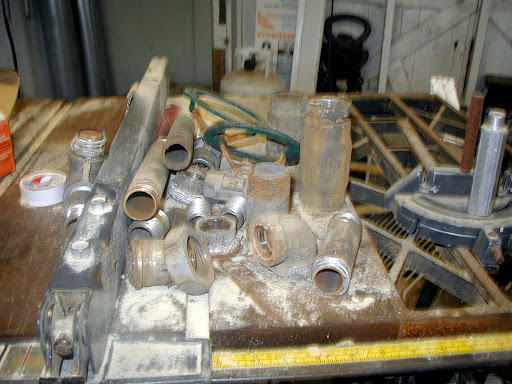 The pressurized tank is installed after the pump and before any outlet for water. My pump switch was a 30/50, meaning it would turn on at 30 psi and turn off at 50 psi. The tank is rated at 100 psi maximum so I'm well within range. The tank was dry and I adjusted the pressure in the tank to work with the pump switch. The tank came with 38 psi, I reduced that to 28 psi which is 2 psi BELOW the pump cut-in switch. In the picture above notice the priming tee above the pump. This is where I needed to add water to ensure the pump did not run dry. It took exactly one gallon of water to fill the pump and piping above the check valve.
The pressurized tank is installed after the pump and before any outlet for water. My pump switch was a 30/50, meaning it would turn on at 30 psi and turn off at 50 psi. The tank is rated at 100 psi maximum so I'm well within range. The tank was dry and I adjusted the pressure in the tank to work with the pump switch. The tank came with 38 psi, I reduced that to 28 psi which is 2 psi BELOW the pump cut-in switch. In the picture above notice the priming tee above the pump. This is where I needed to add water to ensure the pump did not run dry. It took exactly one gallon of water to fill the pump and piping above the check valve.Notice the pressure gage on the pump housing. I first thought the pressure gage was not working, or the pump was not producing pressure in the line. The gage is on the suction side of the pump, so while the pump is running there is NO pressure and the gage reads 0 psi. When the pump stops the gage reads 50 psi. By moving the pressure gage to the output side of the pump, the gage will then read between 30 psi and 50 psi. This is more useful because you can see when the line looses pressure. I plan to make this change.
The output goes to a hose faucet for now. I put some thought into this setup before starting. I built a platform for the pump and tank to sit on, then put unions into the line. When the cottage gets raised to it's final height, I will then disconnect the suction line at the unions and replace a 6" pipe for a 10' pipe. The pump and tank will be installed under the cottage directly below the utility room, which is where the tank will also be installed. For now, I have water to mix concrete and morter, and for general use.



